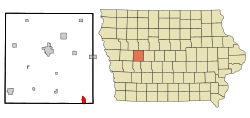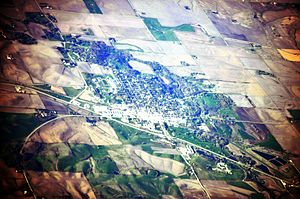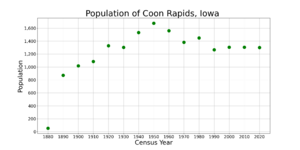Coon Rapids, Iowa facts for kids
Quick facts for kids
Coon Rapids, Iowa
|
|
|---|---|

Location of Coon Rapids, Iowa
|
|
| Country | United States |
| State | Iowa |
| Counties | Carroll, Guthrie |
| Incorporated | November 2, 1882 |
| Area | |
| • Total | 1.78 sq mi (4.62 km2) |
| • Land | 1.78 sq mi (4.62 km2) |
| • Water | 0.00 sq mi (0.00 km2) |
| Elevation | 1,194 ft (364 m) |
| Population
(2020)
|
|
| • Total | 1,300 |
| • Density | 729.11/sq mi (281.52/km2) |
| Time zone | UTC-6 (Central (CST)) |
| • Summer (DST) | UTC-5 (CDT) |
| ZIP code |
50058
|
| Area code(s) | 712 |
| FIPS code | 19-16050 |
| GNIS feature ID | 2393629 |
Coon Rapids is a city in Carroll and Guthrie counties in the state of Iowa. In 2020, about 1,300 people lived there. This number is a little smaller than it was in 2000. A small part of Coon Rapids is also near the bigger city of Des Moines.
Contents
History of Coon Rapids
How Coon Rapids Started
In 1864, two friends, Crocket Ribble and Jacob Cretsinger, bought land near the Middle Raccoon River. They built a mill to cut wood and grind grain. They also opened a post office called Coon Rapids. Soon, stagecoaches traveling to Sioux City would stop there.
After the Civil War, two veterans, William Minnich and Michael Shettler, saw how much potential the area had. They bought land and planned out the village of Coon Rapids. They built a store and hotel, which was also home to the Shettler family.
Growth and Challenges
Between 1870 and 1880, Coon Rapids grew. More people moved there, and new businesses opened. There were general stores, a hardware store, and even a real estate agent.
Around 1880, a railroad company started building a train line nearby. This brought many workers and new jobs. The town started to boom! Businesses from the old village moved closer to the new railroad. Coon Rapids nearly doubled in size.
In 1886, a strong tornado hit Coon Rapids, damaging the eastern part of town. People from all over the United States helped the town rebuild. However, the wooden buildings were still at risk from fires. Many fires happened between 1887 and 1894, some caused by lightning or sparks.
A Modern Town Emerges
By the late 1800s, Coon Rapids began to rebuild with brick buildings that could resist fire. The town added many modern things like theaters, roller skating rinks, bowling alleys, and restaurants. There were also wooden sidewalks and street lights. The town had a night watch and sheriff to keep things safe.
Coon Rapids became a center for the surrounding farms. People from the countryside would come to town for celebrations like July 4th. The town even had its own baseball team!
Supporting Farmers and Local Businesses
As farming grew, Coon Rapids added more services to help farmers. There were carpenters to build farm buildings and people who dug wells. Businesses sold cement and fencing. A creamery opened to support dairy and poultry farms.
By the early 1900s, Coon Rapids was the main trading center between Perry and Manning. The downtown area had many shops, services, and fun places like an opera house and a hotel. Coon Rapids became the main place for business, fun, and services for a large area. It stayed important even during tough times like the Great Depression.
Innovation and International Connections
Coon Rapids has a history of new ideas in business. In the 20th century, businesses focused on farming, like grain dealers, lumber companies, and poultry farms. A very important business for the town was the hybrid corn business.
After World War II, farming changed a lot. Farms became bigger, and large companies took over from individual farmers. For Coon Rapids, this meant changes. A company called Garst and Thomas Seed grew into a worldwide business. It provided many jobs in Coon Rapids. The company even used many downtown buildings for offices and labs.
In September 1959, Coon Rapids played a special role in world history. A local farmer named Roswell Garst hosted the leader of the Soviet Union, Nikita Khrushchev, on his farm. This visit helped improve relations between the United States and the Soviet Union.
Where is Coon Rapids?
Coon Rapids is located along the Middle Raccoon River.
The city covers about 1.78 square miles (4.62 square kilometers) of land.
People of Coon Rapids
| Historical population | |||
|---|---|---|---|
| Census | Pop. | %± | |
| 1880 | 54 | — | |
| 1890 | 873 | 1,516.7% | |
| 1900 | 1,017 | 16.5% | |
| 1910 | 1,084 | 6.6% | |
| 1920 | 1,328 | 22.5% | |
| 1930 | 1,303 | −1.9% | |
| 1940 | 1,533 | 17.7% | |
| 1950 | 1,676 | 9.3% | |
| 1960 | 1,560 | −6.9% | |
| 1970 | 1,381 | −11.5% | |
| 1980 | 1,448 | 4.9% | |
| 1990 | 1,266 | −12.6% | |
| 2000 | 1,305 | 3.1% | |
| 2010 | 1,305 | 0.0% | |
| 2020 | 1,300 | −0.4% | |
| U.S. Decennial Census | |||
What was the population in 2020?
In 2020, there were 1,300 people living in Coon Rapids. Most people (95.2%) were White. About 3.8% of the population was Hispanic or Latino.
The average age in the city was 41.9 years old. About 27.2% of the people were under 20 years old.
Education in Coon Rapids
Coon Rapids is part of the Coon Rapids–Bayard Community School District. This school district was formed in 1988 when the Bayard and Coon Rapids school districts joined together.
Iowa Great Place Program
In 2005, the Coon Rapids-Whiterock area was chosen as an "Iowa Great Place." This program helps communities that have a rich history and good plans for the future. The goal is to help these places grow and improve.
A group called Whiterock Conservancy works with the City of Coon Rapids and the Coon Rapids Development Group. Whiterock Conservancy helps manage a large area of land (about 5,000 acres) that was given by the Garst family. They work to protect nature, support farming, and allow people to visit and learn.
Coon Rapids received money from the state of Iowa to help with its Great Place program. This money helps restore natural areas, build trails, create parks, and support local businesses and tourism.
Famous People from Coon Rapids
- David Garst (1926–2006) - He was the president of Garst Seed Company and worked with different presidents.
- Roswell Garst (1898–1977) - A very famous farmer who hosted the Soviet leader Nikita Khrushchev on his farm.
- Warren Garst (1850–1924) - He was the 19th governor of Iowa.
- Jay King "Babe" Towne (1880–1938) - An MLB player who played for the Chicago White Sox team that won the 1906 World Series.
See also
 In Spanish: Coon Rapids (Iowa) para niños
In Spanish: Coon Rapids (Iowa) para niños




